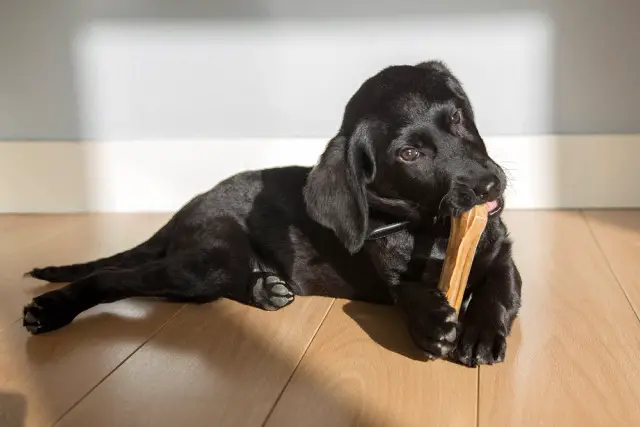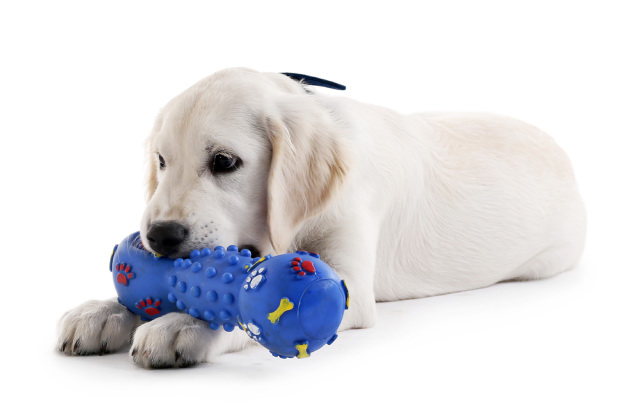If you are fortunate enough to have owned a puppy, you will be familiar with the ‘Parana-like’ phase that surfaces at the onset of teething. Teething is a normal and harmless process, even if your pup ends up swallowing roughly 14 teeth during the process.

It is natural and common for your puppy to swallow their baby teeth when teething. Typically, they end up accidentally swallowing their teeth when eating or drinking.
Since milk teeth are so small, puppies do not even notice they have swallowed one. Swallowing these teeth also poses no danger to their health.
You may very well find one lying around the house or stuck in one of their favorite chew toys.
When Can I Expect Puppy To Lose Their Milk Teeth?
When your puppy is six weeks old, it should have a complete set of shiny white milk teeth. Puppies have 28 deciduous teeth and will end up with 42 permanent teeth.
You can expect your pup to start losing its milk teeth when they are around three months of age, and the teething will most likely only end when they are about 6 to 8 months of age.
Puppies can lose up to three teeth a day, and half or more of these milk teeth are usually swallowed. Your pup may even feel the tooth in their mouth and spit it out, but typically, the tooth gets stuck in a chew toy or pops out during their daily romp or play.
Are There Any Puppy Teething Challenges or Dangers?
Teething is not dangerous and certainly not harmful to your puppy. Here is what you can expect.
Small Amounts of Gum Bleeding
You may notice some minor bleeding from your puppies’ gums or on their chew toys. This happens when a milk tooth has either fallen out or is loose. This bleeding is entirely normal and nothing to be concerned about.
Feeling Under the Weather
Your pup may feel a little sick when teething, but these symptoms are usually short-lived.
Similar to young babies, puppies can also suffer from an upset stomach or loose stools when teething. In most cases, puppies show little to no symptoms and continue on their happy tail-wagging way.
Periodontal Disease and Stubborn Milk Teeth
There is only one occasion where you may need to visit a local vet.
If your pup’s teeth do not fall out (retained deciduous teeth), you may need to have them extracted by a vet. This is usually not very expensive and can be done when or if your puppy is being neutered or spayed.
We recently had our cavapoo spayed and the vet removed two baby teeth at the same time. During our drop-off consultation, the vet showed us the baby teeth he wanted to remove. There was a build-up of food still noticeable in our pup’s mouth, even though she had not eaten since the previous day (due to fasting for her operation).
The vet removed the teeth and within a couple of days, she was her normal bouncy waggy self.
The trouble with retained baby teeth is that food can get trapped between the crowded adult and baby teeth, leading to decay or Periodontal disease. This is exactly the reason the vet wanted to remove these teeth from our dog Coco, a Cavapoo.
Retained teeth can occur in any breed of a puppy but are usually more common in smaller breeds.

How Do You Know If Your Pup Is Teething?
If your pup is teething, nine times out of 10, you will notice it. Teething usually peaks around three or four months of age, when most owners notice something is up.
Biting and Chewing
I spent a couple of months being chased incessantly by my pup. I think she decided it was her mission in life to bite ankles and chew on shoelaces.
Don’t be surprised if your pup looks for anything or everything to chew to soothe those sore gums.
Blood Stains
You will become very aware that your pup wants to chew on everything it can find.
You may notice blood stains on their favorite chew toys or notice a missing tooth or two when they give you their friendly grin.
Face Rubbing
Your pup may rub its face more frequently or even whimper if its gums or mouth are hurting. A puppy’s gums can become sensitive during teething.
Drooling
If your dog is drooling more than usual, this is usually also a sign that they are teething.
Sensitive gums can make it sore for your pup to keep its mouth closed. They often open their mouth more frequently to ease the discomfort, which allows more drool to escape.
Lack of Appetite
Don’t be concerned if your pup is not that interested in mealtimes.
Your pup may temporarily avoid eating due to mouth discomfort. Try offering them wet food as opposed to dry kibble and soak or freeze their kibble before offering it to them, to make eating less uncomfortable.
Some pups are more affected by teething than others. There’s usually no need for a vet visit unless your puppy is really struggling or refusing to play or eat for a couple of days.
A vet will be able to prescribe some pain meds to help your pup through the teething process.
How To Help Your Puppy When They Are Teething
Luckily there are a couple of ways you can help your puppy when they are teething.
Here are a couple of do’s and don’ts to consider:
Never Pull A Puppys’ Milk Teeth Out
Please, do not EVER try to pull your puppy’s loose teeth out. Not only will this be very upsetting for them, but it may also lead to an infection.
The deciduous teeth (baby milk teeth) have longer roots than permanent teeth, and if you tug on them, you may risk breaking the root and leaving parts of the root in their gums. This can later lead to infection.
Pulling at the tooth may also create a negative association for your puppy with you touching their mouth area. This can make future teeth-cleaning routines much harder for you and your puppy.
Offer Cold and Frozen Treats
Cold foods will help numb the puppy’s sore and irritated gums and provide them with some much-needed relief.
Try freezing some frozen vegetables, such as carrots or celery sticks, and offer them as snacks to your pup. If your puppy is not a veggie lover, try offering them ice cubes or frozen dog-friendly broth cubes instead – I don’t know many dogs that will refuse a yummy broth.
We have found our puppy loves ice cubes. She loved batting them around almost as much as she liked eating them.
Even a wet dishcloth that has been frozen and rolled into a ball or twisted can be an excellent soothing chew option for your pup.
Invest in Some Teething Toys
If you would still like to have furniture and carpets after your pup’s teething phase, investing in some chew-friendly teething toys is a good idea.
Here are a couple of chew toys that will help you and your puppy manage their need to bite and chew:
This Nylabone Puppy Chew Freezer Dog Toy is perfect for teething pups. It’s flavored, color-changing, and can be popped in the freezer for a chilled treat.
If your pup’s appetite is being affected, consider this KONG – Puppy Binkie – Soft Teething Rubber, Treat Dispensing Dog Toy. This chew toy may entice them to have a quick snack while satisfying their urge to chew.
Another popular option is the Nylabone Puppy Chew Teething Pacifier Bacon Flavor Small/Regular. It comes in multiple sizes to suit any breed, and the soft material and raised bristles help clean teeth and massage sore gums.
If you can afford it, an assortment of chew toys is the way to go. Please also be sure to puppy-proof your house for any dangerous wires or objects that the puppy may want to chew.
Related Reading:
- Why Puppy Is Digging at the Water Bowl (And How to Stop It)
- How to Get Your Puppy to Sleep Past 6 am: Answered!
- My Dog Ate My Dentures (False Teeth) | Is The Dog OK?
- Cavapoo Dog Bed Size Guide (Puppy to Fully-Grown)
- My Dog Ate My Dentures (False Teeth) | Is The Dog OK?
- Is It Dangerous If a Dog Swallows a Human Tooth?
